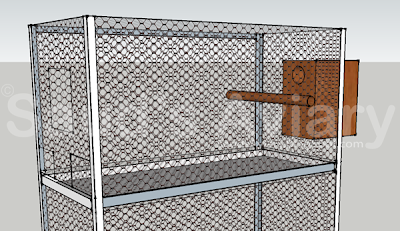Alexandrine Mutations Project: Year 4 (2014)
This post relates to my Alexandrine Mutations Project. If you are new to my blog you should start reading about this project here. A quick summary, I bred two hybrid males split to ino and blue and a hybrid female split to blue in April 2012 from a pairing of a pure Alexandrine male to an Albino Ringneck hen. The two G1 male birds were setup for breeding this season and paired to two pure Alexandrine hens. After some initial skirmishes, both pairs bonded and started visiting the box.
Pair 1
The hen in this pair is a 2 year old, former pet and is semi-tame. She started spending a lot of time in the box during February 2014. She would assume a mating position on the cage floor when I visited her during feeding time. The male would attempt to mount her but once on the back he didn't really know what to do next. I found a broken soft shelled egg on the cage floor on Feb 28th. I immediately started her on liquid calcium but found another soft shelled egg on March 2 outside the box. On March 4th, She laid a normal egg inside the box. I waited for more eggs or for her to start incubation but she did not seem interested in either. After 4 days, I fostered the egg to a ringneck pair that had started a clutch around the same time. A week after incubation, I candled the egg to confirm my suspicion that the egg was clear. After removal of the only egg, the male continued his unsuccessful attempts to mate with her. I waited for her to start a second clutch but she did not lay again.

Pair 2
The hen in the second pair seems older and bigger but the exact age is not known. The pair started spending time in the box early in the season, The shavings were chewed and a clutch did not seem to be far away. I did not catch the pair mating but observed feeding and a strong bond. This pair however did not start a clutch until April 13, 2014. They laid three eggs but unfortunately all turned out to be infertile. I allowed the pair to incubate the eggs just to give them some experience for next year.
Overall, It was a disappointing result but not at all unexpected. Alexandrines take about three years to mature and my hybrid males turned two at the end of this breeding season. It appears that this was the first time for both hens and that also contributed to the result. On the brighter side, both pairs have bonded and gained some valuable experience. My expectations are high for the next season. Until then, I am looking forward to their moult after which they will show their full adult plumage. Solid neck rings will replace their broken rings and I expect their shoulder patches to improve further. My next post will discuss these changes.
Pair 1
The hen in this pair is a 2 year old, former pet and is semi-tame. She started spending a lot of time in the box during February 2014. She would assume a mating position on the cage floor when I visited her during feeding time. The male would attempt to mount her but once on the back he didn't really know what to do next. I found a broken soft shelled egg on the cage floor on Feb 28th. I immediately started her on liquid calcium but found another soft shelled egg on March 2 outside the box. On March 4th, She laid a normal egg inside the box. I waited for more eggs or for her to start incubation but she did not seem interested in either. After 4 days, I fostered the egg to a ringneck pair that had started a clutch around the same time. A week after incubation, I candled the egg to confirm my suspicion that the egg was clear. After removal of the only egg, the male continued his unsuccessful attempts to mate with her. I waited for her to start a second clutch but she did not lay again.

Pair 2
The hen in the second pair seems older and bigger but the exact age is not known. The pair started spending time in the box early in the season, The shavings were chewed and a clutch did not seem to be far away. I did not catch the pair mating but observed feeding and a strong bond. This pair however did not start a clutch until April 13, 2014. They laid three eggs but unfortunately all turned out to be infertile. I allowed the pair to incubate the eggs just to give them some experience for next year.
Overall, It was a disappointing result but not at all unexpected. Alexandrines take about three years to mature and my hybrid males turned two at the end of this breeding season. It appears that this was the first time for both hens and that also contributed to the result. On the brighter side, both pairs have bonded and gained some valuable experience. My expectations are high for the next season. Until then, I am looking forward to their moult after which they will show their full adult plumage. Solid neck rings will replace their broken rings and I expect their shoulder patches to improve further. My next post will discuss these changes.


Best Of Luck for the next season... I hope that you'll get your desired results...
ReplyDeleteOK here you used 2 males with normal Alexandrian females, but whats happened with the female hybrid, which was from 3 chicks
ReplyDeleteYou said it was 2 males and 1 female